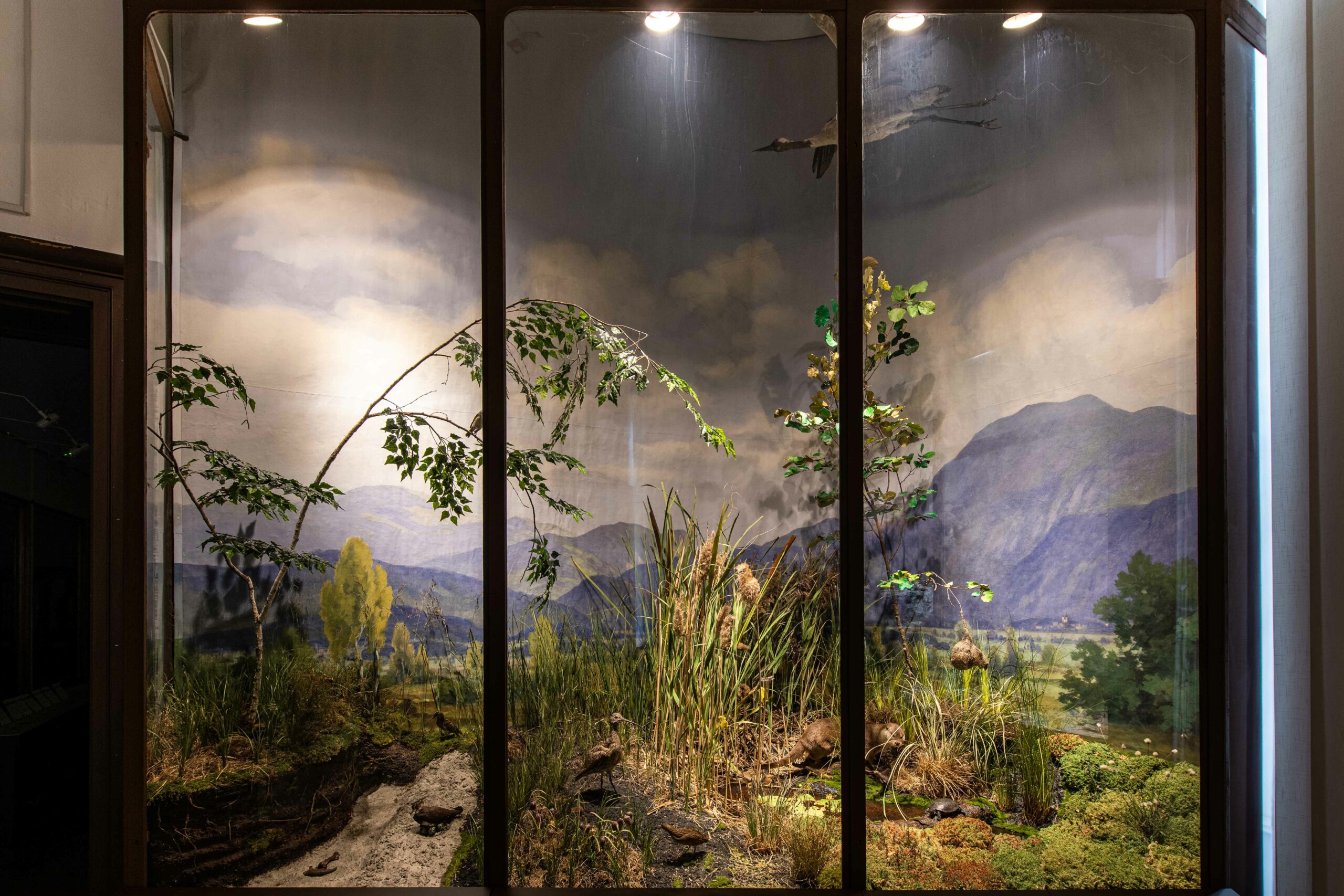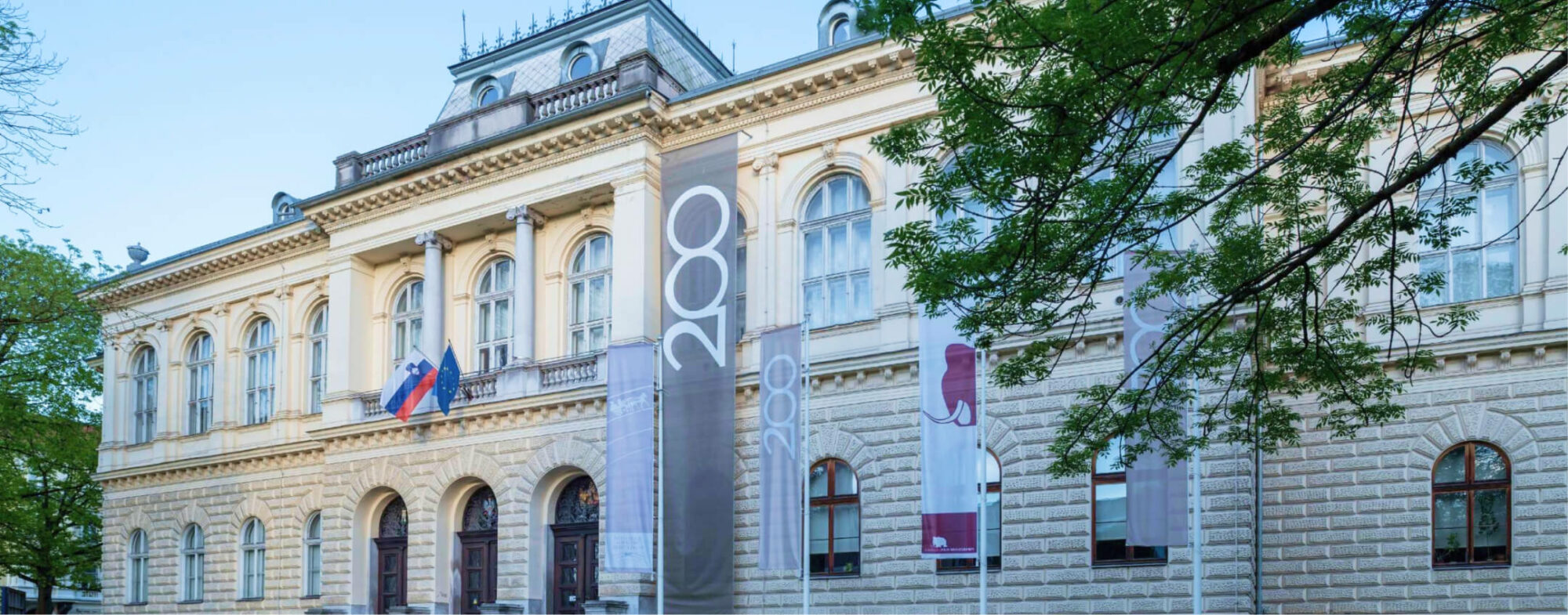The diorama, reconstructed in 2018, depicts Ljubljansko barje at the turn of the 19th century, when its original set up was created. It calls our attention to the changing and disappearing of this raised bog as our ancestors knew it. In the distant past, a lake spread in this area which, however, gradually turned into a swamp and later into a bog. In some places, the layers of peat were even up to nine metres thick. Owing to land draining and economic exploitation of peat, the landscape changed completely in the late 19th century. The swamp and bog were replaced by a cultural landscape with an interlacement of fields and wet meadows, demarcated by belts of trees and bushes. This also led to the disappearance of some animal and plant species and the establishment of new ones, better adapted to the given conditions. Beavers and pink pelicans used to live in and on the shallow lake, while the swamp was later inhabited by bitterns, little bitterns and various ducks.
In the period depicted by the diorama, corncrakes, short-eared owls and curlews bred in wet meadows, the same as lesser grey shrikes in bushes and trees. Recently, the intensive agriculture with the use of pesticides, manuring of meadow land and frequent mowing has brought these species to the brink of extinction, while some, such as the lesser grey shrike and the short-eared owl, simply no longer breed here. Despite this, some rare and endangered species can still be seen at Ljubljansko barje, such as the butterfly false ringlet, the grasshopper Adriatic marbled bush-cricket and the plant snake’s head fritillary. The recently established Ljubljansko barje Landscape Park gives us hope that we shall preserve this area of truly exceptional natural and cultural heritage for our future generations.

The Raised Bog Diorama. Photo: David Kunc
While agricultural work, land reclamation and methodical excavations were carried out at Ljubljansko barje, numerous subfossil remains of animals and plants that lived in this area during the Early Holocene have been found. These remains are usually not yet fully fossilized and are less than 10,000 years old. In addition to beaver bones, the remains of fish, birds, reptiles, wolves, foxes, otters, brown bears, cattle, and other animals and plants were also found. Photo: David Kunc
The European Mole Cricket lives in tunnels dug beneath the surface of moist soil. Each of the males that attract females with loud, sonorous and prolonged chirping, sings one night only. They mate in the tunnel, and the male dies after mating. The female takes care of the eggs and later the larvae in the chamber, which she digs at the end of the tunnel. The entire metamorphosis takes 2 to 3 years. Photo: David Kunc
The Stoat lives in very diverse habitats and can also be found at Ljubljansko barje. It preys mostly on voles and mice. It resembles the Least Weasel (Mustela nivalis), visibly differing from it only by the black-coloured last third of the tail. The abundance of Stoats depends on the abundance of their prey, i.e. voles and mice, which varies greatly over the years. Photo: David Kunc
Male Common Snipe performs courtship display by flying into the air, spreads its tail and slowly descends towards the ground. The same time, the characteristically shaped outer tail feathers vibrate in the air and emit a characteristic bleating sound, after which this bird, called kozica in Slovenian language (literally a small goat) was given its name. Photo: David Kunc
Moors are covered with slow-growing peat mosses. Their lower parts do not rot but carbonize and turn into peat. The layers of peat are then getting slowly but persistently thicker. Until the plants retain their contact with groundwater, this is a fen, but when peat considerably heaps up, the plants can live only on precipitation with an insignificant quantity of nutrients. This is why only the species distinctly adapted to this extreme environment thrive here. In the distant past, the greater part of Ljubljansko barje was covered by raised bog, which was considered the southernmost in Europe.
Common Reed grows up to 3 m tall. It thrives in marshes, bogs and wet meadows, along standing and slow running waters, as well as in moderately salty waters. In times past, fences were made of Common Reed. Hence the genus name Phragmites - the Greek word fragma meaning a fence, wall. Photo: David Kunc
The Yellow Flag Iris grows in ditches, bogs, on the banks of ponds and slow running waters. Like all types of irises, it is a protected plant. Slavic peoples associated irises with Perun, the god of the sky and lightning, while in the Middle Ages this plant was considered a symbol of chivalry. Photo: David Kunc
The Bog-rosemary’s leaves look very much like Rosemary’s leaves. The Bog-rosemary belongs to the heather family, characterized by the obligatory coexistence with fungi, where the fungus supplies the plant with minerals and water, while the plant supplies the fungus with sugars. Photo: David Kunc
The thallus of this type of mosses is composed of living green cells in which photosynthesis takes place, as well as of large colourless dead cells in which water is being stored. In bogs, several peat moss species can be found, which are distributed vertically, subject to humidity conditions. All species are protected in our country. Photo: David Kunc


